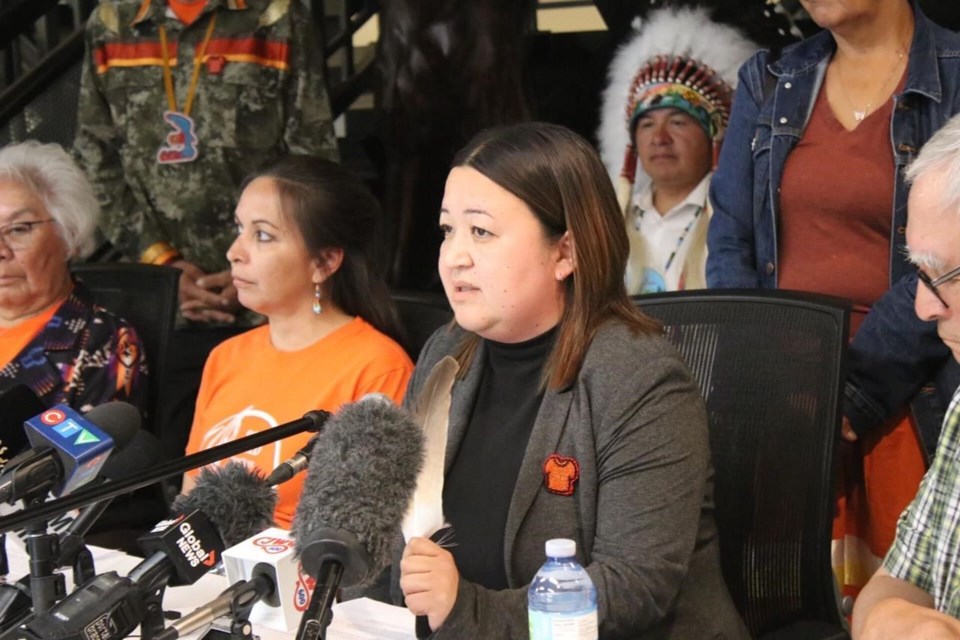SASKATOON — A chief in Saskatchewan says her heart is broken after ground-penetrating radar located 93 areas of interest at the site of a former residential school.
English River First Nation Chief Jenny Wolverine said it’s believed 79 of the areas of interest at the Beauval Indian Residential School could be the size of possible children’s graves and 14 could be the size of ones for infants.
"It breaks my heart that there's likely more, or even that there's even one," Wolverine said Tuesday in Saskatoon.
"The experience of residential school is horrific."
Earlier this month, 83 areas of interest were located at the site and the additional 10 were confirmed as archeological flags were being placed in the area.
Wolverine said the community is saddened at the discovery of more possible graves and it’s clear their work is not over yet.
The First Nation began searching the site in and around the residential school's graveyard two years ago. The graveyard was primarily used by the school until the 1980s.
Wolverine said they didn't know what to expect when they began the project.
"We did know the stories that were shared over generations about the treatment of students and those students who never returned home," she said.
The residential school near Lac la Plonge, a glacial lake in northern Saskatchewan, was operated by the Roman Catholic Church from 1906 to 1969, when it came under federal control. Sixteen different communities in the north had to send their children to the institution.
Nineteen boys and one teacher died in 1927 when the school and its convent caught on fire.
The Meadow Lake Tribal Council took full control of the school in 1985, and the residence was closed 10 years later.
The National Centre for Truth and Reconciliation has a record of 52 children’s deaths at the school.
Survivors told the Truth and Reconciliation Commission, which looked into the legacy of residential schools in Canada, about physical and sexual abuse, humiliation and how their language was restricted.
At least two former staff members, a supervisor and a principal, have convictions for sexually abusing children.
Dawn McIntyre, the ground-penetrating radar co-ordinator for the search, said her father and grandmother attended the school and both brought home trauma from the institution. During this process, McIntyre said she has become acutely aware of how the school shaped her own life.
"These impacts continue to affect us today," she said.
Elders and survivors from the First Nation wrote a statement, read by McIntyre, that said they were shocked, angered and saddened by the discovery of the possible graves.
They said it brought back the turmoil of their childhoods spent in the school.
The survivors called on the federal government to provide ongoing support for searches and to fulfil the calls to action from the Truth and Reconciliation Commission. They also called for churches to respect Indigenous rights and make all documents about the schools available.
The First Nation has said the National Centre for Truth and Reconciliation has a vast amount of records about the school, including handwritten records in French that are being translated. Analyzing the records is expected to take up to three years.
McIntyre said excavation would be a last resort.
The First Nation is closely connected to the Métis community of Patuanak. Métis Nation-Saskatchewan Vice-President Michelle LeClair said it's important that all Indigenous people are unified in the search for answers about their relatives.
"It's a dark part of Canadian history," she said.
Chief Bobby Cameron of the Federation of Sovereign Indigenous Nations, which represents 74 First Nations in Saskatchewan, said the discovery could amount to 93 young boys and girls who were "robbed from their lives."
He called on Prime Minister Justin Trudeau to ensure justice for survivors, their families and children who didn't make it home. He also said healing and wellness centres should be built at the sites of former schools.
"Do the right thing," Cameron said. "Do the honourable thing."
The Indian Residential Schools Resolution Health Support Program has a hotline to help residential school survivors and their relatives suffering trauma invoked by the recall of past abuse. The number is 1-866-925-4419.
This report by The Canadian Press was first published Aug. 29, 2023.
Kelly Geraldine Malone, The Canadian Press
Note to readers: This is a corrected story; A previous version had the incorrect spelling of Justin Trudeau.



